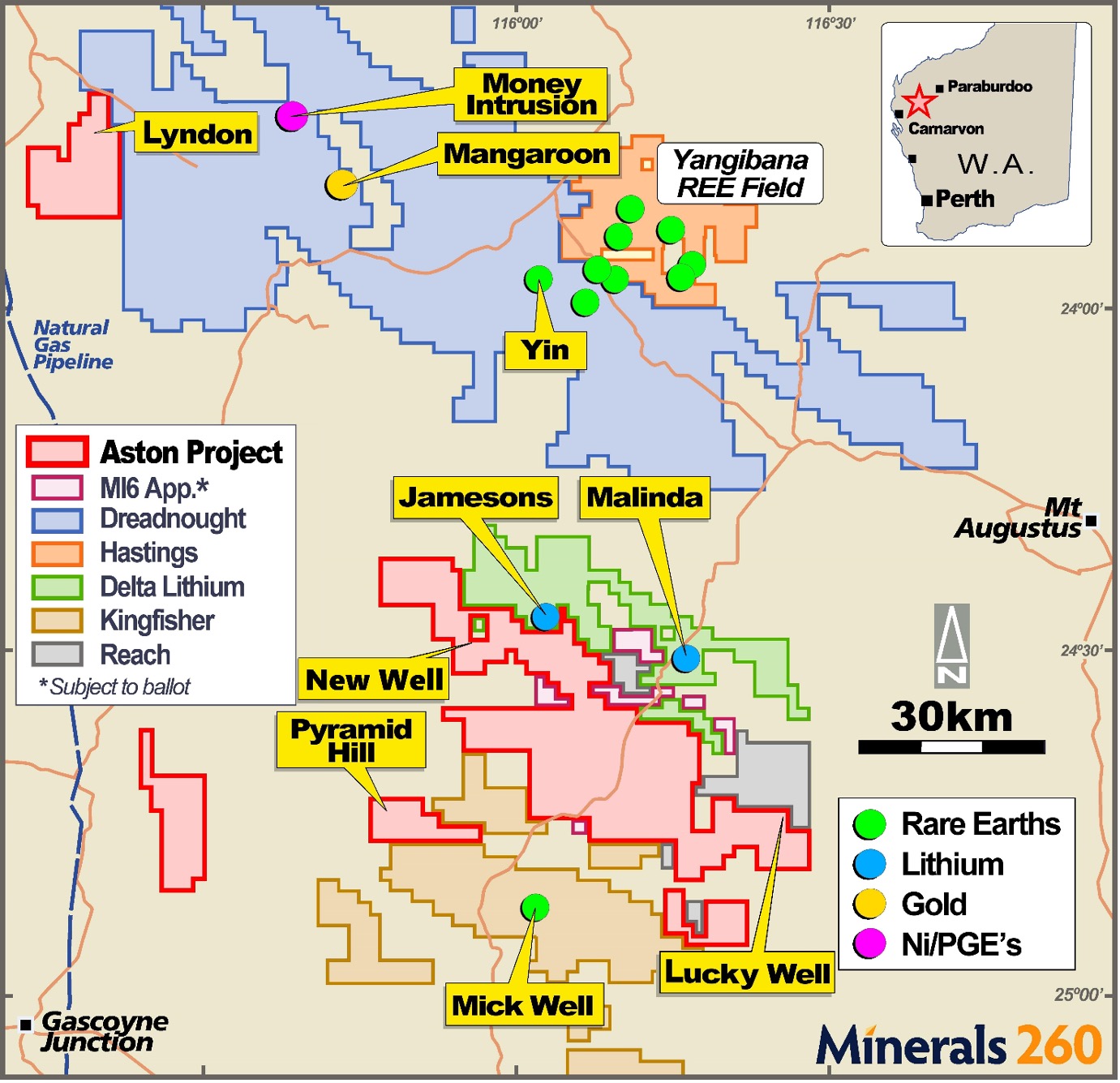Minerals 260 Limited (ASX:MI6) has defined a new Li2O lithium trend with regional soil sampling at the Lyndon prospect within the 100%-owned Aston Project, located in the Gascoyne Province, WA.

The Aston Project is located approximately 230km east of Carnarvon and 850km north of Perth in the Gascoyne Province of Western Australia.
The Gascoyne Province has been explored historically for gold, base metals, tungsten, and uranium; however, recent exploration by neighbouring tenement holders has highlighted the region’s prospectivity for both hard rock hosted lithium (spodumene) and Rare Earth Element (REE) deposits. Recent discoveries include Delta Lithium’s Malinda lithium deposit and Jamesons prospect and Dreadnought Resources’ REE discoveries.
The stratigraphy that hosts the Malinda Deposit (25.7Mt @ 1.0% Li2O and Jamesons prospect is interpreted to trend through the northern part of the Aston Project and soil sampling by Minerals 260 has defined strong lithium anomalism coincident with this trend.
Additionally, soil sampling at the Pyramid Hill prospect, located in the south-western part of the Project area has defined three strong lithium (>100ppm Li2O), tantalum and rubidium anomalies, including a 5km long, continuous trend. Recent infill sampling has further refined one of the anomalies, showing correlation with outcropping pegmatites.
Results from the latest soil sampling have defined anomalous lithium (>100ppm Li2O), tantalum (>100ppm Ta2O5) and rubidium at the Lyndon prospect, located in the north-west of the Project area. Sampling has identified multiple anomalies within a 4.5km x 3km area, with the largest being 2.4km x 1.7km.
Rock chip sampling from Lyndon has recorded anomalous lithium (up to 323ppm Li2O), rubidium (up to 1,340ppm Rb) and tantalum (up to 175ppm Ta2O5) within the >100ppm Li2O soil anomalies, indicating prospectivity for LCT-type pegmatites. Potassium-rubidium (K/Rb) ratios of <30 also suggest prospectivity for lithium mineralisation.
Regional soil sampling at the New Well prospect, ~10km west of Jamesons-Malinda trend and Nardoo Well, has returned results up to 426ppm Li2O, the highest result for the Project since exploration by Minerals 260 began in May 2023. Infill soil sampling is planned in Q2 to better define the anomaly.
Infill and regional soil sampling at the Lucky Well prospect have defined a new 4.1km x 2.2km area that multiple >800ppm TREO anomalies have been located, the largest being 2km x 2.5km with results up to 1,588ppm TREO and 379ppm Nd2O3 + Pr6O.
Reconnaissance rock chip sampling from these anomalies has returned assay results up to 1,369ppm TREO and 356ppm Nd2O3 + Pr6O11, indicating prospectivity for REE carbonatites and ironstones, which will be followed up in future fieldwork.
Results are pending for 784 infill and regional soil samples which are expected to be received in the next 2-3 weeks.
Planning is underway for recommencement of fieldwork in Q2 2024, with this timing aligning with the availability of the Gumala Aboriginal Corporation to undertake required heritage surveys. In addition to the proposed heritage surveys, the additional fieldwork will include further infill sampling over the new Lyndon and other high order geochemical anomalies and finalisation of drill targeting.
“We continue to progress our highly prospective Aston Project in a systematic and phased manner to ensure we have as much data as possible to inform potential future drilling campaigns,” Managing Director Luke McFadyen said.
“We are encouraged with this latest set of results, including new potential drilling targets and the best lithium in soil numbers we’ve seen to date. Drilling at a project of this scale (~1,700 sq. km) and this remote needs to be planned thoroughly and meticulously at every level. While analysis and planning for Aston is ongoing, the drilling at Moora and Koojan is exciting to get underway and we are looking forward to receiving results.”




